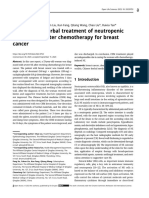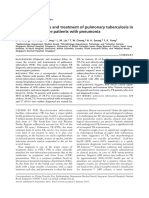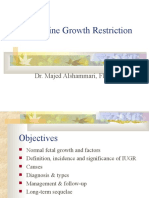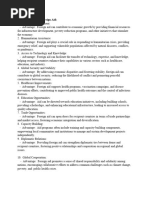Scientific Letters: WWW - Elsevier.es/eimc
Scientific Letters: WWW - Elsevier.es/eimc
Uploaded by
feby1992Copyright:
Available Formats
Scientific Letters: WWW - Elsevier.es/eimc
Scientific Letters: WWW - Elsevier.es/eimc
Uploaded by
feby1992Original Title
Copyright
Available Formats
Share this document
Did you find this document useful?
Is this content inappropriate?
Copyright:
Available Formats
Scientific Letters: WWW - Elsevier.es/eimc
Scientific Letters: WWW - Elsevier.es/eimc
Uploaded by
feby1992Copyright:
Available Formats
Document downloaded from http://http://www.elsevier.pt, day 28/05/2013. This copy is for personal use.
Any transmission of this document by any media or format is strictly prohibited.
Enferm Infecc Microbiol Clin. 2012;30(7):424428
www.elsevier.es/eimc
Scientic letters
Multidrug-resistant tuberculous spondylitis
Espondilitis por tuberculosis multirresistente
To the Editor,
Multidrug-resistant tuberculosis (MDR-TB), dened as resistance to at least isoniazid and rifampin, is an important public
health problem.1 The skeletal system can be involved in 13% of all
tuberculosis cases2 ; however, there are very few reported cases of
skeletal MDR-TB. In addition to the challenges encountered when
treating pulmonary MDR-TB, osteoarticular MDR-TB poses additional difculties, due to the lack of evidence to guide treatment,
the unknown efcacy of second-line antituberculous drugs in the
bone, and the paucity of reports on this condition. We present a
patient with MDR-TB spondylitis with successful response to treatment.
A 32-year-old woman arrived in the emergency department
with a neck injury. One year before admission, she started having
posterior cervical pain and paresthesias in both hands. On admission, the radiography of the cervical spine showed destruction and
collapse of C7 vertebral body (Fig. 1), and a magnetic resonance
showed collapse of C7 and oedema of C6 , C7 , T1 , and T2 vertebral
bodies. She underwent surgical repair with implantation of C7 vertebral prosthesis for stabilisation. The bone biopsy of C7 showed
chronic osteomyelitis and granulomata with central necrosis. The
acid-fast stain was negative. The culture yielded Mycobacterium
tuberculosis, resistant to isoniazid, rifampicin and pyrazinamide,
and sensitive to ethambutol, streptomycin, amikacin, levooxacin,
ethionamide, cycloserine and para-amino salicylic acid.
She was transferred to our tuberculosis unit. On admission, the
physical examination was normal, the HIV serology was negative,
and the chest X-ray was normal.
She started directly observed treatment with ethambutol
1400 mg/day, ethionamide 750 mg/day, cycloserine 750 mg/day,
levooxacin 500 mg/day and intramuscular amikacin 1 g every
48 h. All drugs were administered for 18 months except amikacin,
which was administered for 3 months. There were no adverse
effects except polyarthralgias (which improved after substituting
moxioxacin for levooxacin in the third month). After 18 months
of therapy, she had no symptoms and a CT scan showed complete
resolution of the vertebral lesions. She declined to continue treatment and she did not return for follow-up. However, we contacted
her by telephone 28 months after the end of treatment and she told
us she had no symptoms of relapse.
Spondylitis due to MDR-TB is very infrequent: we have only
found 6 case reports and two small series3,4 in the literature, with
very little information on drug treatment. The optimal treatment
for osteoarticular MDR-TB is unknown. The treatment of nonresistant spinal TB is mainly medical, and surgery is reserved for
managing complications or failure of antimicrobial therapy.2,5,6
0213-005X/$ see front matter 2012 Elsevier Espaa, S.L. All rights reserved.
However, the role of medical and surgical therapy in skeletal
MDR-TB is not well established, nor is it known what drug
combinations would be best to treat this condition. Guidelines for the treatment of MDR-TB have been published,1,7,8 but
they give no specic recommendations for osteoarticular MDRTB.
At the time our patient was treated, we followed the 2008
WHO guidelines,1 which recommended the use of at least
four anti-tuberculosis drugs with either certain, or almost certain,
effectiveness, given as directly observed therapy for a minimum of
18 months after culture conversion. We used a rst-line oral agent
(ethambutol), an injectable agent, a uroquinolone, and two oral
bacteriostatic second-line agents (cycloserine and ethionamide),
as recommended in the WHO guidelines. Although we did not use
it, linezolid is probably worth considering, as it has been extensively used to treat osteoarticular infections and it has good activity
against MDR-TB.9,10 In our case, it was not possible to assess culture conversion, and it might have been reasonable to extend the
treatment time; however, we decided to stop the treatment after
Fig. 1. Radiography of the cervical spine showing destruction and collapse of C7
vertebral body.
Document downloaded from http://http://www.elsevier.pt, day 28/05/2013. This copy is for personal use. Any transmission of this document by any media or format is strictly prohibited.
Scientic letters / Enferm Infecc Microbiol Clin. 2012;30(7):424428
18 months since the patient did not wish to continue, she was
asymptomatic, and there was radiologic evidence of complete
recovery of the bone lesions. The 2011 update to the WHO guidelines has recently increased the recommended treatment time to a
minimum of 20 months.7
References
1. WHO. Guidelines for the programmatic management of drug-resistant tuberculosis. Emergency update 2008. Geneva: World Health Organization; 2008.
2. Tuli SM. General principles of osteoarticular tuberculosis. Clin Orthop Relat Res.
2002;398:119.
3. Pawar UM, Kundnani V, Agashe V, Nene A. Multidrug-resistant tuberculosis
of the spineis it the beginning of the end? A study of twenty-ve culture
proven multidrug-resistant tuberculosis spine patients. Spine (Phila Pa 1976).
2009;34:E80610.
4. Buyukbebeci O, Karakurum G, Daglar B, Maralcan G, Guner S, Gulec A. Tuberculous spondylitis: abscess drainage after failure of anti-tuberculous therapy. Acta
Orthop Belg. 2006;72:33741.
5. Jutte PC, Van Loenhout-Rooyackers JH. Routine surgery in addition to
chemotherapy for treating spinal tuberculosis. Cochrane Database Syst Rev.
2006:CD004532.
6. van Loenhout-Rooyackers JH, Verbeek AL, Jutte PC. Chemotherapeutic treatment
for spinal tuberculosis. Int J Tuberc Lung Dis. 2002;6:25965.
7. WHO. Guidelines for the programmatic management of drug-resistant tuberculosis. 2011 update. Geneva: World Health Organization; 2011.
Fever of intermediate duration in an 8-year-old boy: Is this a
condition worth investigating in childhood?
de 8 anos:
Fiebre de duracin intermedia en un nino
merece la
pena estudiar esta entidad en la infancia?
Dear Editor:
An otherwise healthy 8-year-old boy who lived in a rural area in
Majorca was admitted due to an 11-day history of fever, abdominal pain, listlessness, anorexia, and 2 kg weight loss. He also had
headache and myalgias during the rst few days of the illness.
There were no enlarged lymph nodes, hepatosplenomegaly, or
other positive physical examination ndings. The initial laboratory
tests showed 10,600 leucocytes/mm3 , with 50% neutrophils, and
a C-reactive protein of 15.9 mg/dL. Further laboratory evaluation
on admission including serum alanine and aspartate aminotransferase levels, an ultrasound examination of the liver and the
spleen, and a chest radiography revealed no abnormalities. On the
basis of a working diagnosis of fever of unknown origin (FUO)
a hospital diagnostic work-up was carried out over the following 2 weeks. The assessment consisted of the following studies:
repeated measurements of full blood count (FBC), peripheral smear,
erythrocyte sedimentation rate (ESR), and serum biochemistry,
Mantoux skin test, blood and urine cultures, serology for EpsteinBarr virus (EBV), cytomegalovirus (CMV), adenovirus, inuenza
virus, enteroviruses, herpes simplex viruses, and for Rickettsia
conorii, bone marrow aspirate to rule out malignancies, visceral
leishmaniasis and miliary tuberculosis. The only positive nding
was a gradual increase in the ESR value until a peak of 72 mm/h
on hospital day 14. In the meantime, he continued to be febrile
with spikes up to 39.7 C late evening or at night, despite his
good general condition and an unremarkable physical examination.
However, the childs history of exposure to domestic cats found
out on day 9 of hospitalization prompted us to order serology for
Bartonella henselae. Serology for B. henselae, performed by indirect immunouorescence assay, revealed a positive IgM with an
425
8. Caminero JA, Sotgiu G, Zumla A, Migliori GB. Best drug treatment for
multidrug-resistant and extensively drug-resistant tuberculosis. Lancet Infect
Dis. 2010;10:6219.
9. Yew WW, Chau CH, Wen KH. Linezolid in the treatment of difcult multidrugresistant tuberculosis. Int J Tuberc Lung Dis. 2008;12:3456.
10. Koh WJ, Kwon OJ, Gwak H, Chung JW, Cho SN, Kim WS, et al. Daily 300 mg dose
of linezolid for the treatment of intractable multidrug-resistant and extensively
drug-resistant tuberculosis. J Antimicrob Chemother. 2009;64:38891.
b,
Ins Surez-Garca a, , Jos Ramn Pano-Pardo
Arturo Noguerado c
Infectious Diseases Unit, Department of Internal Medicine, Hospital
Infanta Sofa, San Sebastin de los Reyes, Spain
b Infectious Diseases Unit, Department of Internal Medicine, Hospital
Universitario La Paz, Madrid, Spain
c Tuberculosis Unit, Department of Internal Medicine, Hospital
Cantoblanco-La Paz, Madrid, Spain
Corresponding
author.
E-mail address: inessuarez@hotmail.com (I. Surez-Garca).
doi:10.1016/j.eimc.2012.02.018
IgG titre of 1:1024. The fever abated spontaneously 15 days after
admission.
B. henselae infection should be included in the differential diagnosis of children with FUO, especially if there is a history of kitten or
cat contact, as atypical cat-scratch disease (CSD) can present, irrespective of the immune status of the host, as FUO associated with
hepatosplenomegaly due to hepatosplenic granulomatosis or, even
more rarely, without hepatosplenic involvement.1
Fever of intermediate duration (FID) is a new syndrome, recently
dened by adult infectious diseases specialists in our country as
fever of 728 days which remains unexplained after the patients
history, physical examination, and basic laboratory and imaging
screening. Since treatable infections with a good prognosis are
by far the most commonly aetiology, the proposed diagnostic
approach to this entity allows clinicians to avoid some expensive
and uncomfortable procedures recommended for patients with
classic FUO.2,3 Likewise, although FID has never been studied in
children, the aetiology and prognosis of prolonged fever also varies
greatly depending on whether the fever lasts for more or less than
4 weeks. For example, overall, infections can account for up to 50%
of FUO in children in developed countries.4 The infections most
commonly involved, regardless of local epidemiological particularities, are tuberculosis, EBV and CMV infection, other prolonged
viral infections, CSD, osteomyelitis, and urinary tract infections.4,5
Most of these conditions can currently be diagnosed before fever
reaches 4 weeks with the microbiological tests available. However,
the likelihood of conditions with a worse prognosis such as connective tissue diseases, malignancies or inammatory bowel disease
dramatically increases when fever persists for more than 4 weeks
without a clear origin.58 In times of budget constraints in healthcare, the aetiology of FID is also worth studying in the paediatric
population to optimise its management. We believe that a thorough
clinical history, a meticulous physical examination, and a limited
number of laboratory and imaging tests could be a rational initial
approach to well-appearing and immunocompetent children. Additional investigations can be driven by new diagnostic clues discovered by revisiting the history and repeated physical examination.
You might also like
- MR Heater Manual (Propane Heater)Document20 pagesMR Heater Manual (Propane Heater)daveNo ratings yet
- God's Chosen Fast by Arthur Wallis: FastingDocument4 pagesGod's Chosen Fast by Arthur Wallis: FastingFrank Njoro100% (2)
- HAZOP AnalysisDocument35 pagesHAZOP AnalysisGopi Krish100% (3)
- Potts DiseaseDocument10 pagesPotts DiseasePamela Shiermaine FilomenoNo ratings yet
- (2009) Radiographic Improvement and Its Predictors in Patients With Pulmonary TuberculosisDocument6 pages(2009) Radiographic Improvement and Its Predictors in Patients With Pulmonary TuberculosisMohd RahimiNo ratings yet
- A Case Report On Potts Spine Spinal TubeDocument3 pagesA Case Report On Potts Spine Spinal TubeyaneemayNo ratings yet
- Zarghooni2012 Article TreatmentOfSpondylodiscitisDocument7 pagesZarghooni2012 Article TreatmentOfSpondylodiscitisRoxana StanciuNo ratings yet
- 1 s2Document3 pages1 s2RyanNo ratings yet
- Atorvastatin Improves Sputum Conversion and Chest X-Ray Severity ScoreDocument6 pagesAtorvastatin Improves Sputum Conversion and Chest X-Ray Severity Scorecharmainemargaret.parreno.medNo ratings yet
- International Journal of Infectious DiseasesDocument7 pagesInternational Journal of Infectious DiseasesYuda BeduNo ratings yet
- MDR SleDocument4 pagesMDR SleRamaniya KiranaNo ratings yet
- 6 - Iype2014Document7 pages6 - Iype2014Muhammad SyaifullahNo ratings yet
- 43 Pukar EtalDocument3 pages43 Pukar EtaleditorijmrhsNo ratings yet
- ISM Davit SoesantoDocument14 pagesISM Davit SoesantodavitlieNo ratings yet
- Potts DiseaseDocument6 pagesPotts DiseaseJefferson ManasanNo ratings yet
- Delay in Diagnosis of Extra-Pulmonary Tuberculosis by Its Rare Manifestations: A Case ReportDocument5 pagesDelay in Diagnosis of Extra-Pulmonary Tuberculosis by Its Rare Manifestations: A Case ReportSneeze LouderNo ratings yet
- Lichenoid Drug Reaction To Antituberculosis Drugs Treated Through With Topical Steroids and PhototherapyDocument3 pagesLichenoid Drug Reaction To Antituberculosis Drugs Treated Through With Topical Steroids and PhototherapyChristabella Natalia WijayaNo ratings yet
- Clinical Case of Multidrug-Resistant in King Khalid Hospital, HailDocument2 pagesClinical Case of Multidrug-Resistant in King Khalid Hospital, HailryoNo ratings yet
- Pi Is 1201971213002142Document5 pagesPi Is 1201971213002142melisaberlianNo ratings yet
- Brucilosis and TB ArticleDocument4 pagesBrucilosis and TB Articlesana shakeelNo ratings yet
- WJCC-1-79Document3 pagesWJCC-1-79lya364561No ratings yet
- Treatment of Highly Drug-Resistant Pulmonary TuberculosisDocument10 pagesTreatment of Highly Drug-Resistant Pulmonary TuberculosisErnest ChottaNo ratings yet
- Effect of A Standard Anti-Tuberculosis Regimen On Hematological Parameters and Serum Protein Level in Male Wistar RATSDocument24 pagesEffect of A Standard Anti-Tuberculosis Regimen On Hematological Parameters and Serum Protein Level in Male Wistar RATSEditor IJTSRDNo ratings yet
- Hierbas Chinas Enterocolitis NeutropenicaDocument7 pagesHierbas Chinas Enterocolitis NeutropenicajulianbermudezherreraNo ratings yet
- Junal PyodermaDocument6 pagesJunal PyodermaJares Clinton Saragih SimarmataNo ratings yet
- RecentprogressinthetreatmentofLN PDFDocument12 pagesRecentprogressinthetreatmentofLN PDFHosne araNo ratings yet
- Dapus RaddDocument20 pagesDapus RaddNur Liza SeptianiNo ratings yet
- Pone 0165942Document15 pagesPone 0165942rastiNo ratings yet
- Antibiotics 02 00001Document10 pagesAntibiotics 02 00001Jenny AlmagroNo ratings yet
- Pulmonary Balantidium Coli Infection in A Leukemic PatientDocument4 pagesPulmonary Balantidium Coli Infection in A Leukemic PatientNika Dwi AmbarwatiNo ratings yet
- Clinical and Serological Approach To Patients With Brucellosis - A Common Diagnostic Dilemma and A Worldwide PerspectiveDocument21 pagesClinical and Serological Approach To Patients With Brucellosis - A Common Diagnostic Dilemma and A Worldwide Perspectiveyesenia.hgioNo ratings yet
- Azitromicyn COPDDocument10 pagesAzitromicyn COPDLucrécia BórgiaNo ratings yet
- 2 Ijdrdjun20182Document4 pages2 Ijdrdjun20182TJPRC PublicationsNo ratings yet
- Rheumatology 2008Document3 pagesRheumatology 2008Thelma Cantillo RochaNo ratings yet
- Tuberculous Spondylitis PDFDocument5 pagesTuberculous Spondylitis PDFpuaanNo ratings yet
- Case Report: Tuberculous Spondylitis: A Report of Different Clinical Scenarios and Literature UpdateDocument5 pagesCase Report: Tuberculous Spondylitis: A Report of Different Clinical Scenarios and Literature UpdatepuaanNo ratings yet
- Defenisi PDFDocument2 pagesDefenisi PDFNyoman SuryaNo ratings yet
- Accepted Manuscript: 10.1016/j.jinf.2017.08.005Document28 pagesAccepted Manuscript: 10.1016/j.jinf.2017.08.005Adrian Quiroga RodriguezNo ratings yet
- Eli SpotDocument20 pagesEli SpotAdel HamadaNo ratings yet
- Fungal Liver AbscessDocument7 pagesFungal Liver Abscesshabtsh habshaNo ratings yet
- Research Article: Neutropenic Sepsis in The ICU: Outcome Predictors in A Two-Phase Model and Microbiology FindingsDocument9 pagesResearch Article: Neutropenic Sepsis in The ICU: Outcome Predictors in A Two-Phase Model and Microbiology Findings28121998No ratings yet
- 10 5588@ijtld 14 0963Document8 pages10 5588@ijtld 14 0963Oscar Rosero VasconesNo ratings yet
- Long-Term Low-Dose Erythromycin in Patients With Unexplained Chronic Cough: A Double-Blind Placebo Controlled TrialDocument53 pagesLong-Term Low-Dose Erythromycin in Patients With Unexplained Chronic Cough: A Double-Blind Placebo Controlled TrialRifky MubarakNo ratings yet
- Paper Alumnos 3 PDFDocument10 pagesPaper Alumnos 3 PDFVictor Martinez HagenNo ratings yet
- "Frequency of Diabetes in Relapse TB: Bs Mltresearch Project Submitted By: Syeda Quratulain. 022-CMLT/BS-2015Document5 pages"Frequency of Diabetes in Relapse TB: Bs Mltresearch Project Submitted By: Syeda Quratulain. 022-CMLT/BS-2015AneesUrRahmanNo ratings yet
- Torj 12 125Document4 pagesTorj 12 125Tya VenyNo ratings yet
- Staphy 2Document5 pagesStaphy 2Alexandra MariaNo ratings yet
- Mortality Among Tuberculosis Patients in The Democratic Republic of CongoDocument7 pagesMortality Among Tuberculosis Patients in The Democratic Republic of CongoGary Rios DionicioNo ratings yet
- Interferon Gamma Production in The Course of Mycobacterium Tuberculosis InfectionDocument9 pagesInterferon Gamma Production in The Course of Mycobacterium Tuberculosis InfectionAndia ReshiNo ratings yet
- Meningitis TBDocument11 pagesMeningitis TBErni Yessyca SimamoraNo ratings yet
- Review Afb Neg CultureDocument7 pagesReview Afb Neg Cultureธิรดา สายสตรอง สายจำปาNo ratings yet
- Sternal TuberculosisDocument5 pagesSternal TuberculosissbkinareNo ratings yet
- Recognition of Gout in RADocument4 pagesRecognition of Gout in RAsaphena parvaNo ratings yet
- Admin A 10 1 85 3b9f306Document8 pagesAdmin A 10 1 85 3b9f306Dyanne BautistaNo ratings yet
- Corticosteroids in The Treatment of Vestibular Neuritis: A Systematic Review and Meta-AnalysisDocument7 pagesCorticosteroids in The Treatment of Vestibular Neuritis: A Systematic Review and Meta-AnalysisshiloinNo ratings yet
- Prevalence and Drug Resistance of Nontuberculous Mycobacteria, Northern China, 2008-2011Document2 pagesPrevalence and Drug Resistance of Nontuberculous Mycobacteria, Northern China, 2008-2011Mark ReinhardtNo ratings yet
- Disseminated Tuberculosis in An AIDS/HIV-Infected Patient: AbstractDocument3 pagesDisseminated Tuberculosis in An AIDS/HIV-Infected Patient: AbstractAmelia Fitria DewiNo ratings yet
- Analysis of 30 Patients With Acupuncture-Induced Primary Inoculation TuberculosisDocument8 pagesAnalysis of 30 Patients With Acupuncture-Induced Primary Inoculation TuberculosisGaneshRajaratenamNo ratings yet
- Validation of The Meet URO Score in Patients WithDocument9 pagesValidation of The Meet URO Score in Patients Withveaceslav coscodanNo ratings yet
- TORCH Salmeterol Fluticasona en EpocDocument15 pagesTORCH Salmeterol Fluticasona en EpocAgustina AndradeNo ratings yet
- Immunophenotyping Techniques for Biomedical Scientists: Continuing Professional Development in Pathology For Medical Laboratory ProfessionalsFrom EverandImmunophenotyping Techniques for Biomedical Scientists: Continuing Professional Development in Pathology For Medical Laboratory ProfessionalsNo ratings yet
- BMHP JKN Tanggamus-2 9102019Document42 pagesBMHP JKN Tanggamus-2 9102019pindo indra gunawanNo ratings yet
- Glandular EpitheliumDocument10 pagesGlandular EpitheliumAbby Claire SomeraNo ratings yet
- Blood Bank EquipmentDocument41 pagesBlood Bank EquipmentHuzaifa UjjainNo ratings yet
- C25 33 Generating SetDocument2 pagesC25 33 Generating SetНиколай ТаранNo ratings yet
- Biography of Marie CurieDocument3 pagesBiography of Marie CurieJessy CristanchoNo ratings yet
- Cold Chain Locator DraftDocument23 pagesCold Chain Locator DraftSpandan GhoshNo ratings yet
- Week 4 Lecture Notes On Tissues, Membranes, Inflammation and Tissue Repair STUDENTDocument48 pagesWeek 4 Lecture Notes On Tissues, Membranes, Inflammation and Tissue Repair STUDENTwarrenjames0217No ratings yet
- Salt AnalysisDocument6 pagesSalt AnalysisARTHUR BALAJI RNo ratings yet
- Dr. Yoshikas Resrach Paper On PATM Disease Rare DiseaseDocument1 pageDr. Yoshikas Resrach Paper On PATM Disease Rare DiseaseMuhammad AliNo ratings yet
- I - Basic ProbabilityDocument3 pagesI - Basic ProbabilityChiara Liveta RodriguezNo ratings yet
- BP V&V Workshop 20 February 2019 Duri: © 2019 PT. Chevron Pacific IndonesiaDocument2 pagesBP V&V Workshop 20 February 2019 Duri: © 2019 PT. Chevron Pacific IndonesiaJimmy TambaNo ratings yet
- Hotel Details Check in Check Out Rooms: Guest Name: DateDocument1 pageHotel Details Check in Check Out Rooms: Guest Name: DateSunil ChejaraNo ratings yet
- Case Study 3 - Change in Demand and Quantity DemandedDocument2 pagesCase Study 3 - Change in Demand and Quantity DemandedSatishNo ratings yet
- Tamil Nadu Sugar OutputDocument3 pagesTamil Nadu Sugar OutputjeganrajrajNo ratings yet
- Research On Social Work Practice: Applying Diffusion of Innovation Theory To Intervention DevelopmentDocument17 pagesResearch On Social Work Practice: Applying Diffusion of Innovation Theory To Intervention DevelopmentYunita RamonsyahNo ratings yet
- Fundamentals of HealthCare 50 ItemsDocument13 pagesFundamentals of HealthCare 50 ItemsDefensor Pison Gringgo100% (8)
- Intrauterine Growth Restriction: Dr. Majed Alshammari, FRSCSDocument72 pagesIntrauterine Growth Restriction: Dr. Majed Alshammari, FRSCSapi-3703352No ratings yet
- Download ebooks file Hepatology a clinical textbook 2010 2nd edition Editors all chaptersDocument77 pagesDownload ebooks file Hepatology a clinical textbook 2010 2nd edition Editors all chapterskrilemistigo100% (6)
- Fitoterapia: Chuan-Yang Zhang, Jian-Guang Luo, Rui-Huan Liu, Ru Lin, Ming-Hua Yang, Ling-Yi KongDocument6 pagesFitoterapia: Chuan-Yang Zhang, Jian-Guang Luo, Rui-Huan Liu, Ru Lin, Ming-Hua Yang, Ling-Yi Kongmuhammad faqihNo ratings yet
- 11.6 Further Thermochemical Processes: 374 Biomass and BiofuelsDocument24 pages11.6 Further Thermochemical Processes: 374 Biomass and BiofuelsEswahyudiKurniawanNo ratings yet
- VSR 421 Regional Vet SurgeryDocument233 pagesVSR 421 Regional Vet SurgeryPavan S N PavanNo ratings yet
- Megaplex-4 System MN 4.91Document1,181 pagesMegaplex-4 System MN 4.91jerryhamstersgNo ratings yet
- Advantages and Disadvantages of Foreign AidDocument2 pagesAdvantages and Disadvantages of Foreign Aidsjner2056No ratings yet
- CHAMUKA MSocSci TR14 206 PDFDocument174 pagesCHAMUKA MSocSci TR14 206 PDFPaidashe Chamuka100% (1)
- Work Shop Hazards FinalDocument3 pagesWork Shop Hazards FinalAlexutza StanNo ratings yet
- ITC Product MixDocument21 pagesITC Product MixklvtharunNo ratings yet
- The Role of Disintegrants in Solid Oral Dosage ManufacturingDocument17 pagesThe Role of Disintegrants in Solid Oral Dosage ManufacturingRhosuna Aina0% (1)

























































































